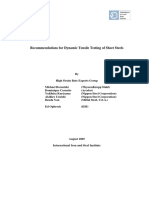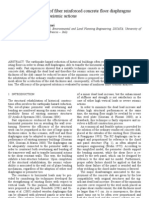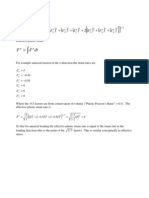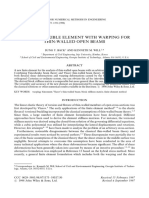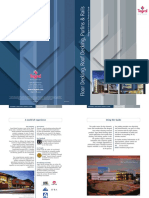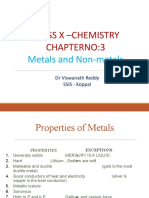03 - Hilti Shear Connectors X-HVB
03 - Hilti Shear Connectors X-HVB
Uploaded by
ing urbanCopyright:
Available Formats
03 - Hilti Shear Connectors X-HVB
03 - Hilti Shear Connectors X-HVB
Uploaded by
ing urbanOriginal Description:
Original Title
Copyright
Available Formats
Share this document
Did you find this document useful?
Is this content inappropriate?
Copyright:
Available Formats
03 - Hilti Shear Connectors X-HVB
03 - Hilti Shear Connectors X-HVB
Uploaded by
ing urbanCopyright:
Available Formats
X-HVB
X-HVB shear connectors
Product data
Dimensions
X-HVB 140
General information
Material specifications
X-HVB 125
127.5
142.5
X-HVB
Carbon steel:
Zinc coating:
X-ENP-21 HVB
Carbon steel shank: HRC58
Zinc coating:
816 m
2.5
2.5
20.6
31
51
63
63
X-HVB 95
Fastening tools and equipment
Tool
DX 76 PTR
Fastener Guide
X-76-F-HVB-PTR
Piston
X-76-P-HVB-PTR
Cartridges
6.8/18 M black, red
(for details see
application limit
X-ENP-21 HVB)
95
112.5
X-HVB 110
20.6
31
51
20.6
31
51
63
50
60
Rm = 295350 N/mm2
3 m
24.3
See fastener selection for more details.
Approvals and design guidelines
X-HVB 80
SOCOTEC (France)
X-HVB 50
DIBt (Germany)
50
60
24.3
24.3
50
88
X-ENP-21 HVB
52
SCI (UK), TZS (Czech)
80
Note: technical data presented in these approvals and
design guidelines reflect specific local conditions and
may differ from those published in this handbook.
If the fastening is subject to an approval process or
where a design guideline must be used, technical data
in the approval or design guideline has precedence
over data presented here. Approval copies are available from your Hilti technical advisory service.
25.8
o 7.4
o 4.5
yellow
o 15
11 / 2009
2.39
X-HVB
Applications
Examples
Shear connectors for
building construcions:
composite beam action
end anchorage of
composite decking
floor diaphragm
resist lateral buckling
Design data
Solid slabs
Nominal
Characteristic shear
resistance
PRk [kN] 1)
Design shear
resistance
PRd [kN] 2)
Allowable horizontal Allowable resistance
shear
(working load)
q [kN] 3)
RD [kN] 4)
X-HVB 50
23
18
N.A
13
X-HVB 80
28
23
14
16
X-HVB 95
35
28
17.5
22
X-HVB 110
35
28
17.5
22
X-HVB 125
35
28
17.5
22
X-HVB 140
35
28
17.5
22
As defined in EN 1994-1-1 (Nominal strength in AISC-LRFD; unfactored shear resistance in CISC, Qk in BS
5950:3:3.1:1990)
2)
As defined in EN 1994-1-1 (Qp in BS 5950:3:3.1:1990)
3)
Allowable shear in AISC-ASD
4)
Allowable shear for working load design
1)
2.40
11 / 2009
X-HVB
Reduction factors for profile metal decks
Ribs transverse to beams
K
b
h h
0 sc ap
kt =
Nr hap
hap
EN 1994-1-1 designs:
K = 0.70
Nr = HVBs / rib ( 2 in the calculation even if 3 are placed in
a rib)
Note: kt 1.0
Ribs parallel to beams
AISC, CISC, BS 5950, other design codes:
K = 0.85
Nr = HVBs / rib (1, 2 or 3)
for
b0
1.8 kp = 1.0
hap
for
b0
b0
hsc hap
< 1.8 kp = 0.6 x
hap
hap
hap
Note: kp 1.0
Engineering advice
Connector placement along the beam
The HVB is a flexible connector and may be uniformly distributed between points where large
changes in shear flow occur. These points may be supporting points, points of application of
point loads or areas with extreme values of bending moments.
Partial shear connection
Strength:
The minimum connection depends on the design code used:
a) In EN 1994-1-1 and BS 5950 designs, N/Nf , must be at least 0.4. This is increased depending on span length and decking geometry.
b) In AISC, N/Nf must be at least 0.25.
c) In CISC, N/Nf must be at least 0.50.
Deflection control only:
If the shear connection is needed for deflection control only, there is no minimum degree of connection. However, minimum allowable connector spacing applies and steel beam must have
enough strength to carry the self-weight and all imposed loads.
11 / 2009
2.41
X-HVB
Application requirements
Thickness of base material
Minimum thickness of steel base material tII = 8 mm
1 x 1.25
Thickness of fastened material
Maximum thickness of decking tI = 1.25 mm
Connector positioning, spacing and edge distances
General positioning
or
or
Position the HVBs so that the shear force is transferred symmetrically to the beam. The HVB
orientation parallel to the axis of the beam is preferred.
Positioning on metal decks - ribs transverse to beam
1) One, two or three HVB's per rib
parallel to beam
2.42
perpendicular to beam
11 / 2009
X-HVB
2a) Position in the rib : 1 HVB per rib leg centred in the rib or 40 mm clearance
=
40 mm
2b) With 2 or 3 HVBs per rib legs centred in the rib or alternated about the centre
=
3) Spacing along the ribs
basic minimum spacing, a 50 mm
a 100 mm for:
bo/m < 0.7 and bo/hap < 1.8
SDI 3 composite decking (USA)
50 mm
m = rib spacing
Positioning on solid slabs and metal decks ribs parallel to beam
4 hc
600 mm
100 mm
4 hc
600 mm
100 mm
hc
50 mm
hc
With 1 connector per row, alternate direction of connectors from X-HVB to X-HVB.
With 2 or 3 connectors per row, alternate direction of connectors inside of each row and
from row to row.
11 / 2009
2.43
X-HVB
Clearance to metal decking
bo 60 mm
Split decking if necessary for spacing / clearance
Corrosion information
The intended use only comprises fastenings which are not directly exposed to external
weather conditions or moist atmospheres.
Application limits
Application limits are valid only if correct cartridge and power setting are used!
Application limits X-ENP-21 HVB
>20
Cartridge preselection and power setting
>20
10
10
18
18
17
16
15
14
13
Applicable
range of base
materials
12
11
10
9
8
S 235
S 275
S 355
6
350 400 450 500 550 600 650 700 750
Steel strength, Rm [N/mm2]
In thermo-mechanically rolled construction
steel, e.g. S 355M per EN 10025-4 the application limit is reduced by 50 N/mm2
2.44
Steel thickness tII [mm]
Steel thickness, tII [mm]
17
16
15
14
Black 4
from
10 mm
Black 4
from
10 mm
13
12
11
10
9
Black 3
Red 4
Black 2
8
S 235
S 355
Fine adjustment by setting tests on site
11 / 2009
X-HVB
1 x 1,25
b0
8 mm
hap
hsc
hc
Fastener selection
b0
Connector
Designation
Item no.
Maximum decking height hap [mm]
b0 / hap < 1.8
b0 / hap 1.8
X-HVB 50
56467
Not for use with profiled decking
X-HVB 80
239357
45
45
X-HVB 95
239358
60
57
X-HVB 110
239359
75
66
X-HVB 125
239360
80
75
X-HVB 140
239361
80
80
all connectors with two nails
X-ENP-21 HVB
283512
Fastening quality assurance
Fastening inspection
hNVS
X-HVB
Metal decking
Structural steel
X-ENP-21 HVB hNVS = 8.29.8 mm
11 / 2009
2.45
2.46
11 / 2009
You might also like
- Composite Floor Decks: Steel Floor Decking SystemsDocument60 pagesComposite Floor Decks: Steel Floor Decking SystemsRubabath BavaNo ratings yet
- Plates and Shells: Instructor's Solutions ManualDocument3 pagesPlates and Shells: Instructor's Solutions Manualehab elsawyNo ratings yet
- The Finite Element MethodDocument13 pagesThe Finite Element MethodNaresh GajNo ratings yet
- OCEN 201 Introduction To Ocean & Coastal EngineeringDocument28 pagesOCEN 201 Introduction To Ocean & Coastal EngineeringbalumaxNo ratings yet
- CCTVDDocument20 pagesCCTVDSteven SunNo ratings yet
- Modeling The Hysteretic Response of Mechanical Connections For Wood StructuresDocument11 pagesModeling The Hysteretic Response of Mechanical Connections For Wood StructuresSheff_studentNo ratings yet
- Appendix D Review of Mechanics of Materials - 2009 - Elasticity Second Edition PDFDocument14 pagesAppendix D Review of Mechanics of Materials - 2009 - Elasticity Second Edition PDFJaimeNo ratings yet
- 1893-Part 1-2016-1 PDFDocument44 pages1893-Part 1-2016-1 PDFDarshit Vejani100% (3)
- Ecocem BrochureDocument16 pagesEcocem Brochureing urbanNo ratings yet
- CISPI Pipe and Fittings HandbookDocument226 pagesCISPI Pipe and Fittings HandbookThantZin111No ratings yet
- 03 - Hilti Shear Connectors X-HVB PDFDocument8 pages03 - Hilti Shear Connectors X-HVB PDFing urbanNo ratings yet
- 2009 (Tomazevic) Seismic Upgrading of Old Masonry BuildingsDocument29 pages2009 (Tomazevic) Seismic Upgrading of Old Masonry BuildingsRafael RuizNo ratings yet
- HighStrainRate Recommended Procedure PDFDocument30 pagesHighStrainRate Recommended Procedure PDFSivaraman VisvanathanNo ratings yet
- Shear Resistance of Masonry Walls and Eurocode 6: Shear Versus Tensile Strength of MasonryDocument20 pagesShear Resistance of Masonry Walls and Eurocode 6: Shear Versus Tensile Strength of MasonryScribd2015No ratings yet
- DTD Handbook: Section 2.2.6.3. Crack Opening DisplacementDocument4 pagesDTD Handbook: Section 2.2.6.3. Crack Opening Displacementpouya_msNo ratings yet
- Pavia - Design of Masonry Structures With Bed Joint ReinforcementDocument20 pagesPavia - Design of Masonry Structures With Bed Joint ReinforcementamaliaconstantinNo ratings yet
- A New Higher Order Shear DeforDocument8 pagesA New Higher Order Shear Deforamira khaldiNo ratings yet
- 1952 G Gerard & S Wildhorn A Study of Poisson's Ratio in The Yield Region NASA TN 2561Document31 pages1952 G Gerard & S Wildhorn A Study of Poisson's Ratio in The Yield Region NASA TN 2561raduag7No ratings yet
- Study of Interfacial Pressure Distribution For Preloaded Bolted ConnectionDocument6 pagesStudy of Interfacial Pressure Distribution For Preloaded Bolted ConnectionRohit JayashreeNo ratings yet
- Abaqus BucklingDocument9 pagesAbaqus BucklingMaria FlorNo ratings yet
- A State-of-the-Art Review On Fatigue Life Assessment PDFDocument14 pagesA State-of-the-Art Review On Fatigue Life Assessment PDFJosé GarridoNo ratings yet
- The Art of Structural DesignDocument176 pagesThe Art of Structural DesignYorman LPNo ratings yet
- Accuracy of Nonlinear Static ProceduresDocument20 pagesAccuracy of Nonlinear Static ProceduresShyamNo ratings yet
- Multi-Scale Analyses On Seismic Damage and Progressive Failure ofDocument12 pagesMulti-Scale Analyses On Seismic Damage and Progressive Failure ofMehranVaNo ratings yet
- S TimoshenkoDocument29 pagesS TimoshenkoJose Rojas-GuzmanNo ratings yet
- Pushover AnalysisDocument20 pagesPushover AnalysisMarcelo Quisbert100% (2)
- Performance of Joints in Steel Storage Pallet RacksDocument11 pagesPerformance of Joints in Steel Storage Pallet RacksMichael Torres100% (1)
- Shear Buckling AnalysisDocument20 pagesShear Buckling AnalysisstarspleshNo ratings yet
- Finite Element Analysis of Sandwich PlatesDocument7 pagesFinite Element Analysis of Sandwich Platesthanhcong313No ratings yet
- CHAPTER 1 - Introduction To Shell TheoryDocument24 pagesCHAPTER 1 - Introduction To Shell TheoryDavid NashNo ratings yet
- List of Assignment: Two Dimensional Vector Variable ProblemsDocument1 pageList of Assignment: Two Dimensional Vector Variable Problemsnavneetkpatil8409No ratings yet
- Bolt Design For Repeated LoadingDocument13 pagesBolt Design For Repeated Loadingchandrasingh4564No ratings yet
- Some Contributions of Physical and Numerical Modelling To The Assessment of Existing Masonry Infilled RC Frames Under Extreme LoadingDocument10 pagesSome Contributions of Physical and Numerical Modelling To The Assessment of Existing Masonry Infilled RC Frames Under Extreme LoadingRick HunterNo ratings yet
- Special Issue "Stability and Nonlinear Analysis of Steel Structures - Research Advances"Document228 pagesSpecial Issue "Stability and Nonlinear Analysis of Steel Structures - Research Advances"biomechanicsNo ratings yet
- PERFORMANCE-BASED DESIGN SeminarDocument4 pagesPERFORMANCE-BASED DESIGN SeminarJose Maria GedaNo ratings yet
- RTD 1016-1 (2017) Version 2.1 Guidelines For Nonlinear Finite Element Analysis of Concrete StructuresDocument69 pagesRTD 1016-1 (2017) Version 2.1 Guidelines For Nonlinear Finite Element Analysis of Concrete StructuresGeorgia SkroumpelouNo ratings yet
- Seismic Design of Composite Metal Deck and Concrete Filled Diaphragms A Discussion Paper Cowie Hicks Macrae Clifton FussellDocument11 pagesSeismic Design of Composite Metal Deck and Concrete Filled Diaphragms A Discussion Paper Cowie Hicks Macrae Clifton Fussellmongkol_1001No ratings yet
- A Practical Method For Proper Modeling of Structural Damping in Inelastic Plane Structural Systems PDFDocument9 pagesA Practical Method For Proper Modeling of Structural Damping in Inelastic Plane Structural Systems PDFCarlos Ivan Troncoso OrtegaNo ratings yet
- Full Download Theory and Computation in Hydrodynamic Stability 2nd Edition W. O. Criminale PDFDocument52 pagesFull Download Theory and Computation in Hydrodynamic Stability 2nd Edition W. O. Criminale PDFtuyetpajnic100% (3)
- 2010 Nonlinear FE Analysis of FRC Floor Diaphragms Undergoing Horizontal Seismic ActionsDocument6 pages2010 Nonlinear FE Analysis of FRC Floor Diaphragms Undergoing Horizontal Seismic ActionsPratikNo ratings yet
- MSC Sahc SguerraDocument130 pagesMSC Sahc SguerraSoniaGPNo ratings yet
- Application of FRP Composites For Underwater PilesDocument9 pagesApplication of FRP Composites For Underwater Pileswendydy6No ratings yet
- Dynamic Analysis of Large-Diameter Sagged PDFDocument19 pagesDynamic Analysis of Large-Diameter Sagged PDFKedarNo ratings yet
- Nonlinear Analysis of Structures PDFDocument38 pagesNonlinear Analysis of Structures PDFRabindraSubediNo ratings yet
- Cdnj04820enc 001Document362 pagesCdnj04820enc 001Oscar CcamaNo ratings yet
- Equivalent Plastic StrainDocument1 pageEquivalent Plastic Strainardi7020023615No ratings yet
- Nonlinear Spring Element (Combin 39)Document19 pagesNonlinear Spring Element (Combin 39)mansoor_yakhchalian2No ratings yet
- Finite Element Analysis of Circular Annular PlatesDocument9 pagesFinite Element Analysis of Circular Annular PlatesLakshman ReddyNo ratings yet
- Shear-Flexible Element With Warping For Thin-Walled Open BeamsDocument19 pagesShear-Flexible Element With Warping For Thin-Walled Open BeamsnevinkoshyNo ratings yet
- EN1994 2 KuhlmannDocument108 pagesEN1994 2 KuhlmannJoão Duarte Canha100% (1)
- 8552Document6 pages8552staedtlerpNo ratings yet
- Damage Mechanics in Metal Forming: Advanced Modeling and Numerical SimulationFrom EverandDamage Mechanics in Metal Forming: Advanced Modeling and Numerical SimulationRating: 4 out of 5 stars4/5 (1)
- Hands-On Simulation Modeling with Python,: Develop simulation models for improved efficiency and precision in the decision-making processFrom EverandHands-On Simulation Modeling with Python,: Develop simulation models for improved efficiency and precision in the decision-making processNo ratings yet
- Methodologies for Seismic Safety Evaluation of Existing Nuclear InstallationsFrom EverandMethodologies for Seismic Safety Evaluation of Existing Nuclear InstallationsNo ratings yet
- Introduction to the Explicit Finite Element Method for Nonlinear Transient DynamicsFrom EverandIntroduction to the Explicit Finite Element Method for Nonlinear Transient DynamicsNo ratings yet
- Probabilistic service life model of RC structures subjected to the combined effect of chloride-induced corrosion and cyclic loadingFrom EverandProbabilistic service life model of RC structures subjected to the combined effect of chloride-induced corrosion and cyclic loadingNo ratings yet
- Cyclic Plasticity of Engineering Materials: Experiments and ModelsFrom EverandCyclic Plasticity of Engineering Materials: Experiments and ModelsNo ratings yet
- Plates and Shells for Smart Structures: Classical and Advanced Theories for Modeling and AnalysisFrom EverandPlates and Shells for Smart Structures: Classical and Advanced Theories for Modeling and AnalysisRating: 5 out of 5 stars5/5 (1)
- Technical Manual Schoeck Isokorb (5185) 2016-02-10Document158 pagesTechnical Manual Schoeck Isokorb (5185) 2016-02-10ing urbanNo ratings yet
- Design of Single Span Beams in SLSDocument15 pagesDesign of Single Span Beams in SLSing urbanNo ratings yet
- Comflor Floordecking PDFDocument39 pagesComflor Floordecking PDFing urbanNo ratings yet
- LUNOS Catalogue For Home VentilationDocument68 pagesLUNOS Catalogue For Home Ventilationing urbanNo ratings yet
- Specifying Sustainable Concrete PDFDocument26 pagesSpecifying Sustainable Concrete PDFing urbanNo ratings yet
- 03 - Ancon Shear Load Connectors DWGDocument1 page03 - Ancon Shear Load Connectors DWGing urbanNo ratings yet
- Step by Step Guide To Using The CV Facility On FÁS Jobs IrelandDocument28 pagesStep by Step Guide To Using The CV Facility On FÁS Jobs Irelanding urbanNo ratings yet
- Lunos Domestic Ventilation Systems With Heat RecoveryDocument5 pagesLunos Domestic Ventilation Systems With Heat Recoverying urbanNo ratings yet
- Technical Data Sheet For HIT-HY-200 Injectable Mortar For Anchor and Rebar Technical Information ASSET DOC 2331175Document85 pagesTechnical Data Sheet For HIT-HY-200 Injectable Mortar For Anchor and Rebar Technical Information ASSET DOC 2331175ing urbanNo ratings yet
- Technical Data Sheet For HIT-HY 170 Injectable Mortar For Anchor in Concrete Technical Information ASSET DOC 4398553Document31 pagesTechnical Data Sheet For HIT-HY 170 Injectable Mortar For Anchor in Concrete Technical Information ASSET DOC 4398553ing urban100% (2)
- 8vhuvjxlgh 6fuhzzlwkgudzdouhvlvwdqfhphwhu:) Dnrss (Qwhusulvh +èjidoyd) HQ/ X +xqjdu/ ZzzidnrssfrpDocument5 pages8vhuvjxlgh 6fuhzzlwkgudzdouhvlvwdqfhphwhu:) Dnrss (Qwhusulvh +èjidoyd) HQ/ X +xqjdu/ Zzzidnrssfrping urbanNo ratings yet
- Exemple de Calcul Si Scheme LogiceDocument1 pageExemple de Calcul Si Scheme Logiceing urbanNo ratings yet
- Ruukki Classic C D Installation Instructions PDFDocument28 pagesRuukki Classic C D Installation Instructions PDFing urbanNo ratings yet
- Combustión: Section 3Document9 pagesCombustión: Section 3Luciana RequejoNo ratings yet
- Returning Materials For Storage DisposalDocument74 pagesReturning Materials For Storage Disposaledgardo.salcedo001100% (1)
- 3 Blanket and Roller Wash GuideDocument24 pages3 Blanket and Roller Wash GuidearieldlustreNo ratings yet
- 1 - Analysis of Saturated and Aromatic HydrocarbonsDocument17 pages1 - Analysis of Saturated and Aromatic HydrocarbonsFaisal SaifNo ratings yet
- Chemical Industry PCMA Members DirectoryDocument24 pagesChemical Industry PCMA Members DirectoryAli AhmedNo ratings yet
- MF8791-BE - IV YEAR Paste QuestionDocument8 pagesMF8791-BE - IV YEAR Paste QuestionPriyadharshan RNo ratings yet
- Material Science and Metallurgy PDFDocument1 pageMaterial Science and Metallurgy PDFGopi KrishnaNo ratings yet
- Chemical EquilibriumDocument25 pagesChemical EquilibriumEng D A MaxNo ratings yet
- SAE J78 & ASME B18.6.3 Zinc: Self Drilling Screws, HWH, UnslottedDocument16 pagesSAE J78 & ASME B18.6.3 Zinc: Self Drilling Screws, HWH, UnslottedCesar ZarateNo ratings yet
- Maraging 300Document9 pagesMaraging 300Almerindo JuniorNo ratings yet
- Tannin Extraction Pretreatment of Acorn StarchDocument35 pagesTannin Extraction Pretreatment of Acorn Starchkwayneolson6081No ratings yet
- RFCDocument788 pagesRFCArslan AkbarNo ratings yet
- Metals and Non-MetalsDocument37 pagesMetals and Non-MetalsNeeraj Ilal67% (3)
- Cost-Analysis - 2.0Document17 pagesCost-Analysis - 2.0AYUS BUILDERS & ENTERPRISESNo ratings yet
- Chapter 20Document35 pagesChapter 20Sigmund PohanNo ratings yet
- ExplorationofbanafibreDocument3 pagesExplorationofbanafibreRalph Justine HernandezNo ratings yet
- Produccion Cacao Colombia (Cascara de Cacao)Document7 pagesProduccion Cacao Colombia (Cascara de Cacao)JENNIFER TATIANA PORRAS OLIVEROSNo ratings yet
- The Nature of Chemistry: John W. Moore Conrad L. StanitskiDocument54 pagesThe Nature of Chemistry: John W. Moore Conrad L. StanitskiBeastUnleashed28No ratings yet
- Papel Mo Uling KoDocument19 pagesPapel Mo Uling KoPrecious B. BesoniaNo ratings yet
- Conclusion and RecommendationDocument2 pagesConclusion and Recommendationjoandalilis7316No ratings yet
- Visual Inspection VT BookDocument50 pagesVisual Inspection VT Bookkhaledharaz1997No ratings yet
- CBSE NCERT Solutions For Class 7 Science Chapter 4: Back of Chapter QuestionsDocument4 pagesCBSE NCERT Solutions For Class 7 Science Chapter 4: Back of Chapter QuestionsPugalmeena PugalmeenaNo ratings yet
- Daggerz Brand Construction FastenersDocument3 pagesDaggerz Brand Construction FastenersmurdicksNo ratings yet
- Module-2 Grade7 Sciencestudy WellDocument20 pagesModule-2 Grade7 Sciencestudy Wellnee nineNo ratings yet
- Gujarat Technological UniversityDocument1 pageGujarat Technological Universityghogharikuldip10No ratings yet
- Design of Anchor Channels - USA - JordahlDocument76 pagesDesign of Anchor Channels - USA - JordahlZlatko BiočićNo ratings yet
- ch9 1Document38 pagesch9 1Karam AlmasriNo ratings yet
- Influence of Alccofine in UHPCDocument9 pagesInfluence of Alccofine in UHPCAhmadNo ratings yet
- Zhang2015 Article ResearchOnResidualBendingCapacDocument10 pagesZhang2015 Article ResearchOnResidualBendingCapacHeru P SoehardjoNo ratings yet













